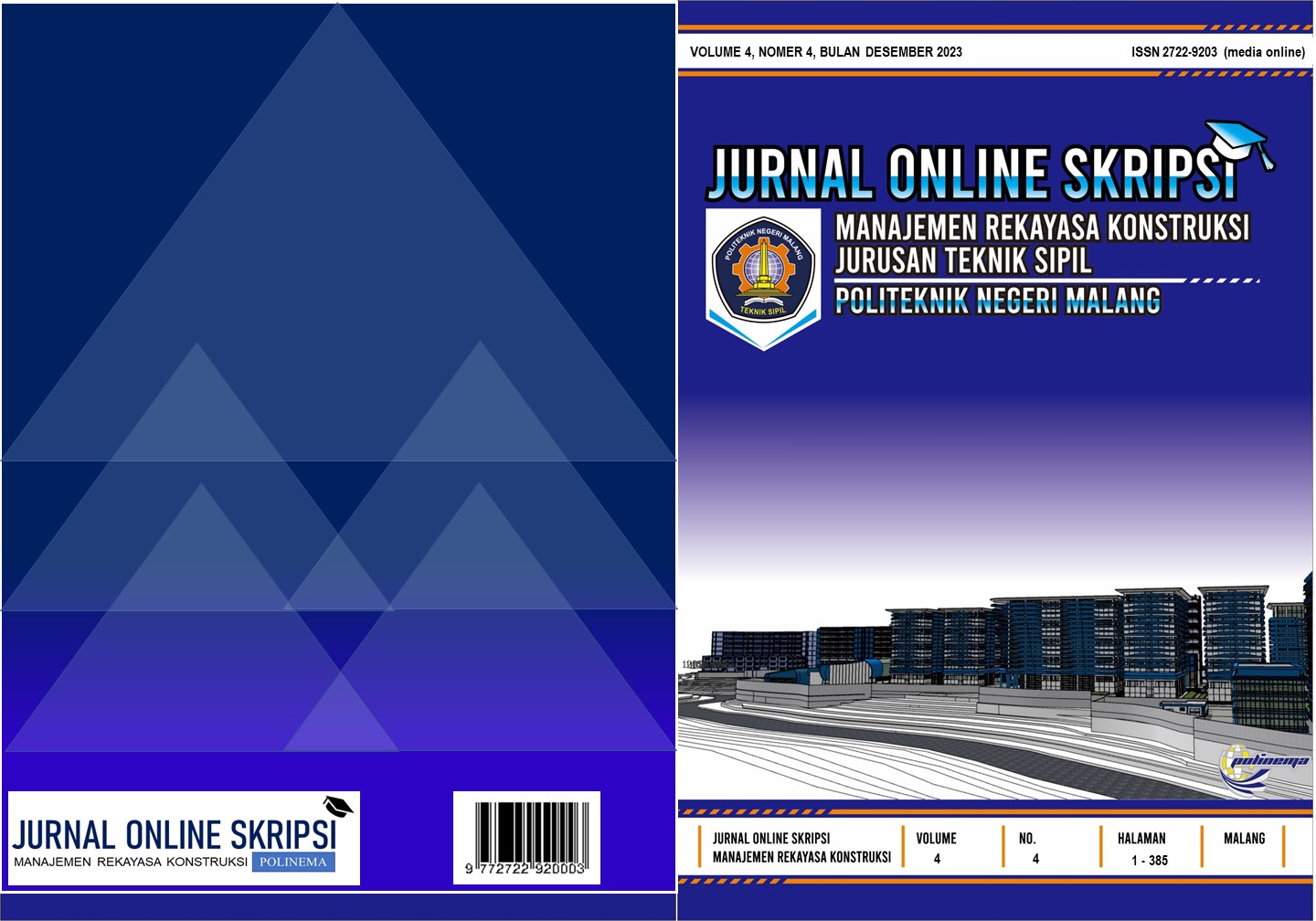Main Article Content
Abstract
Sukun District frequently experiences flooding during the rainy season, particularly when rainfall exceeds two hours, due to blockages in drainage channels, population growth and a limited number of inlets. This study aims to evaluation flood discharge, determine the necessary dimensions for drainage channels and inlets, as well as estimate the cost of redesigning. The required data for this study included daily rainfall data from 2013-2022 obtained from Sukun, Ciliwung, and Dau stations, existing channel dimensions, a topographic map, and the 2022-unit price of work in Malang city. The data were processed using the Log-Pearson III distribution to determine the flood design for a 10-year return period. The intensity of rain was calculated using the Mononobe formula. The Storm Water Management Model (EPA-SWMM 5.1) was employed to simulate the quality of surface runoff, as well as the flow rate. The results of the Log-Pearson III distribution indicated that the maximum recorded rainfall was 93.827 mm/day, which was deemed acceptable based on the Chi-Square and Smirnov-Kolmogorov test results. The simulation revealed that the existing drainage channels have a capacity of 1.648 m3/sec, which is insufficient to handle the design discharge of 1.685 m3/sec. As a result, overflow occurs during peak flow conditions, indicating that four channels (RT4C, RT4F, RT4H and RT4I) are not effective to convey the 10 years return period of discharge. However, the simulation also demonstrated that the proposed redesign of the drainage channels, which involves increasing the channel height depending on the amount of discharge each channel should accommodate while keeping the width constant due to space limitations, significantly improves their capacity. The redesigned channels have a capacity of 2.278 m3/sec, exceeding the design discharge of 1.685 m3/sec. The new design ensures that the channels can accommodate the expected volume of water without experiencing overflow, even during peak flow conditions. The estimated cost of this redesign is IDR 280,450,000.
Keywords
Article Details
References
- Chow, V. T., Maidment, D. R., & Mays, L. W. (1988). Applied hydrology. McGraw-Hill.
- Dewi, R. S. (2014). Analysis of Drainage System and Design of Drainage Improvement for Solo-Sragen Road. Civil Engineering Dimension, 7–16.
- Djojowirono, S. (1984). Cost budget plan in construction projects. Journal of Construction Engineering and Management.
- Kodoatie, R. J. (2005). Urban drainage systems: a tool for sustainable development. Water Science and Technology, 51–53.
- Mato, Blasius Lobe, & Suhudi. (2012). Evaluation System Network Drainage on Jalan Seokerno Hatta Malang. Buana Science 12, 85–90.
- Rossman, L. A. (2017). Storm Water Management Model. Reference Manual Volume II - Hydraulics, EPA/600/R-17/111, Volume II (National Risk Management Laboratory, U.S. Environmental Protection Agency, Cincinnati, OH).
- Sherman, L. K. (1992). Frequency and Intensity of United States rainfall. U.S. Weather Bureau., 67.
- Soemarto, S. (1995). Hidrologi untuk pengairan. Jakarta: PT. Pradnya Paramita.
- Suripin. (2004). Sustainable Urban Drainage System. Yogyakarta: Andi.
- Yen, B. C., & Chow, W. K. (2013). A review of open channel flow modeling techniques. Journal of Hydraulic Engineering, 139.
References
Chow, V. T., Maidment, D. R., & Mays, L. W. (1988). Applied hydrology. McGraw-Hill.
Dewi, R. S. (2014). Analysis of Drainage System and Design of Drainage Improvement for Solo-Sragen Road. Civil Engineering Dimension, 7–16.
Djojowirono, S. (1984). Cost budget plan in construction projects. Journal of Construction Engineering and Management.
Kodoatie, R. J. (2005). Urban drainage systems: a tool for sustainable development. Water Science and Technology, 51–53.
Mato, Blasius Lobe, & Suhudi. (2012). Evaluation System Network Drainage on Jalan Seokerno Hatta Malang. Buana Science 12, 85–90.
Rossman, L. A. (2017). Storm Water Management Model. Reference Manual Volume II - Hydraulics, EPA/600/R-17/111, Volume II (National Risk Management Laboratory, U.S. Environmental Protection Agency, Cincinnati, OH).
Sherman, L. K. (1992). Frequency and Intensity of United States rainfall. U.S. Weather Bureau., 67.
Soemarto, S. (1995). Hidrologi untuk pengairan. Jakarta: PT. Pradnya Paramita.
Suripin. (2004). Sustainable Urban Drainage System. Yogyakarta: Andi.
Yen, B. C., & Chow, W. K. (2013). A review of open channel flow modeling techniques. Journal of Hydraulic Engineering, 139.
